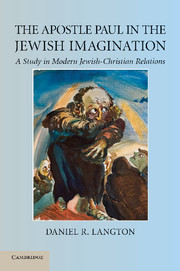Book contents
- Frontmatter
- Contents
- Acknowledgments
- Introduction
- PART I THE APOSTLE PAUL AND POPULAR JEWISH CULTURAL IDENTITY
- PART II THE APOSTLE PAUL AND JEWISH RELIGIOUS IDENTITY: NEW TESTAMENT STUDIES AND THEOLOGICAL APPROACHES
- PART III THE APOSTLE PAUL AND JEWISH INTEREST IN THE JUDEO-CHRISTIAN TRADITION: ARTISTIC AND LITERARY APPROACHES
- PART IV THE APOSTLE PAUL AND JEWISH CRITIQUES OF THE PLACE OF RELIGION IN SOCIETY: PHILOSOPHICAL AND PSYCHOANALYTICAL APPROACHES
- 7 The Philosophical Writings of Baruch Spinoza, Lev Shestov, and Jacob Taubes
- 8 The Psychoanalytical Writings of Sigmund Freud and Hanns Sachs
- Conclusion
- Appendix: The Story of Abbu Gulish in The Book of Tales
- Bibliography
- Scripture and Other Ancient Writings Index
- General Index
- References
8 - The Psychoanalytical Writings of Sigmund Freud and Hanns Sachs
Published online by Cambridge University Press: 07 May 2010
- Frontmatter
- Contents
- Acknowledgments
- Introduction
- PART I THE APOSTLE PAUL AND POPULAR JEWISH CULTURAL IDENTITY
- PART II THE APOSTLE PAUL AND JEWISH RELIGIOUS IDENTITY: NEW TESTAMENT STUDIES AND THEOLOGICAL APPROACHES
- PART III THE APOSTLE PAUL AND JEWISH INTEREST IN THE JUDEO-CHRISTIAN TRADITION: ARTISTIC AND LITERARY APPROACHES
- PART IV THE APOSTLE PAUL AND JEWISH CRITIQUES OF THE PLACE OF RELIGION IN SOCIETY: PHILOSOPHICAL AND PSYCHOANALYTICAL APPROACHES
- 7 The Philosophical Writings of Baruch Spinoza, Lev Shestov, and Jacob Taubes
- 8 The Psychoanalytical Writings of Sigmund Freud and Hanns Sachs
- Conclusion
- Appendix: The Story of Abbu Gulish in The Book of Tales
- Bibliography
- Scripture and Other Ancient Writings Index
- General Index
- References
Summary
From its inception, psychoanalysis has had a complicated relationship with Judaism. Freud himself was anxious to prevent the association of his new science with Jews for fear that it would not be taken seriously by an anti-Semitic establishment. And yet, until Jung joined it, the psychoanalytical association was almost exclusively composed of Jews. As one contemporary, a British professor at Harvard, observed,
The famous theory of Freud is a theory of the development and working of the mind which was evolved by a Jew who has studied chiefly Jewish patients; and it seems to appeal very strongly to Jews; many, perhaps the majority of those physicians who accept it as a new gospel, a new revelation, are Jews.
It is by no means only those hostile to the therapeutic system who regard it as some sort of Jewish science (as the Nazis notoriously referred to it). Anna Freud herself once described it as such, and David Meghnagi has suggested that the birth of psychoanalysis should be understood as ‘a cultural event within Judaism’, as a sublimated answer to the problems posed by secularisation and as a rejection of an authentic integration of Jews into Christian European society. He argued that it is best appreciated when it is set alongside the rise of the sociopolitical movements of Zionism and the Bund, that is, alongside Jewish nationalism and Jewish socialism.
- Type
- Chapter
- Information
- The Apostle Paul in the Jewish ImaginationA Study in Modern Jewish-Christian Relations, pp. 263 - 278Publisher: Cambridge University PressPrint publication year: 2010



